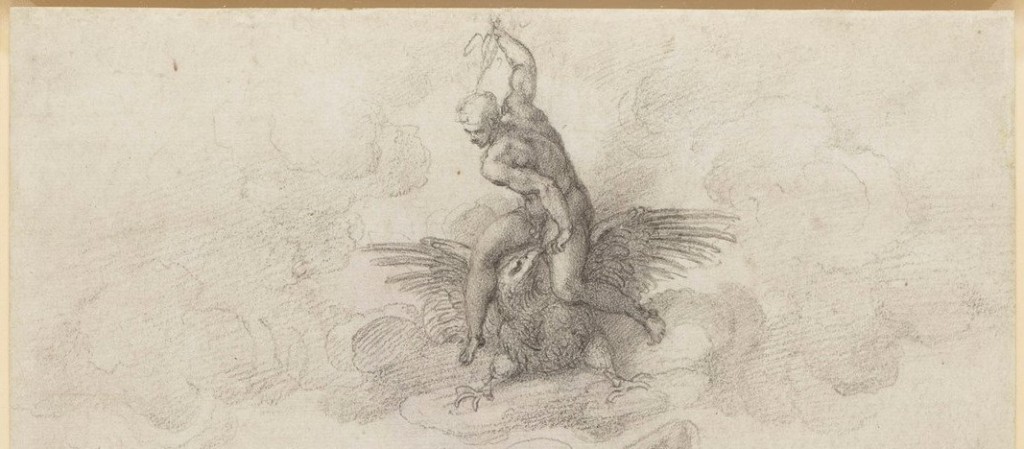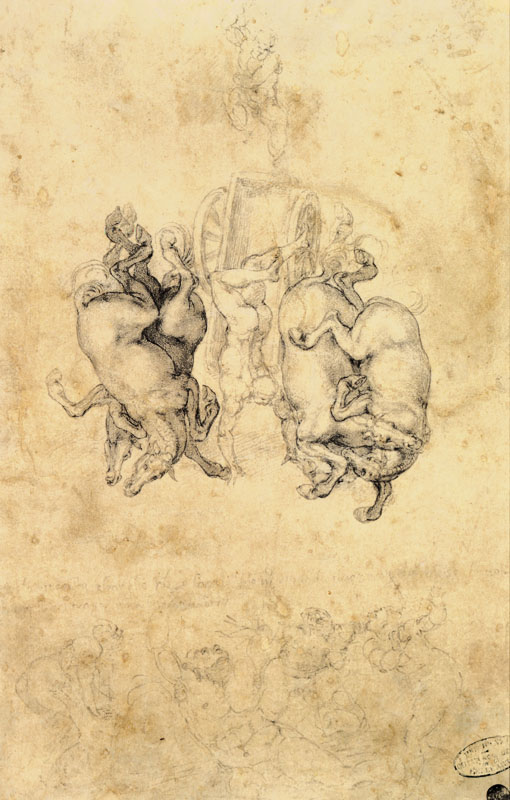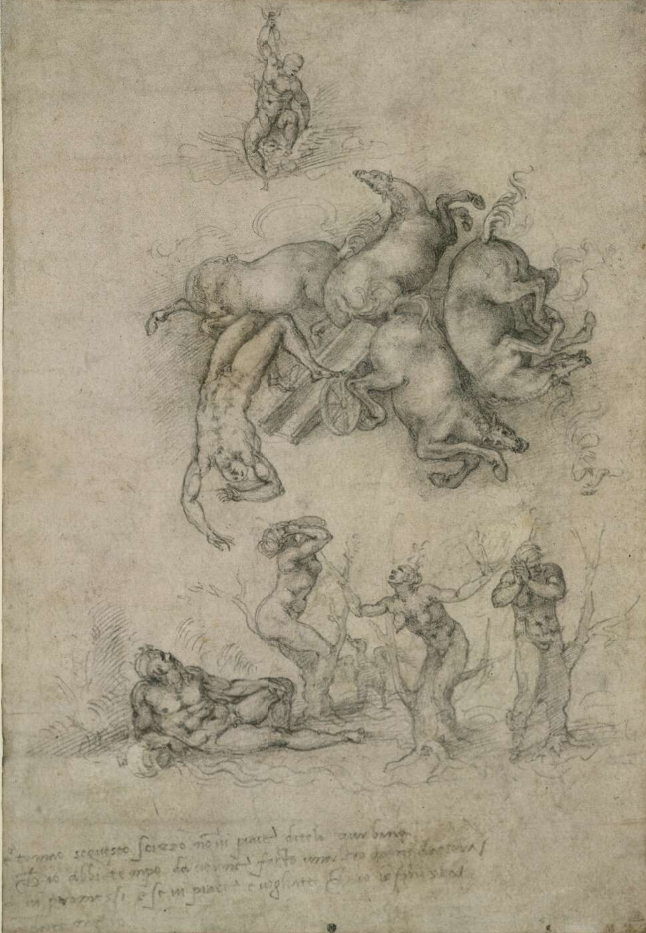Michelangelo, The Fall of Phaethon, 1533. The Royal Collection/HM King Charles III.
This week, a drawing from the Royal Collection – it seems apt. And, although Monday sees the funeral of its former owner, Queen Elizabeth (she held it in trust for the nation), I have decided to go ahead with my talk, Michelangelo 3: The Works on Paper. Between those who believe that we should stop our normal activities as a sign of respect, and those who wish to carry on to honour our late Queen’s memory and celebrate a steadfast life, I have decided to leave the choice to you: feel free to join me from 5:30-7:30pm, or to take some quiet time for yourselves. Future plans, including a talk on the National Gallery’s revelatory exhibition Winslow Homer: Force of Nature, are listed in the diary.

The talk on Monday will cover different forms of ‘work on paper’. Drawings, yes, but also letters and poetry. And of course there were many different types of drawing – preliminary sketches, compositional studies, detailed analyses of form, cartoons, and architectural plans to name the most important. But this – this is something else. All the other types of drawing listed are preparatory works, made to enable the completion of a painting, sculpture or building. This is not preparatory, it is a work of art in its own right, to be presented to someone as a completed project in and of itself, and this gives it its title: a presentation drawing. The composition, on a sheet of paper in portrait format, is clearly divided into three main sections structured as a pyramid, with two elements – man and bird – at the apex, six in the centre, and seven or more at the base. We’ll start by looking at the central section, as it is this which gives the drawing its title.

We see a chariot – reduced to a simple box-like element with a wheel on either side – a male nude, and four horses in free fall. Given the small scale (the drawing is 23.4 cm wide) the detail is remarkable. The nude is Phaeton, and he is almost upside down, his left arm curled round his head, the right arm extended. There is a bend in his torso, stretching the skin over his left ribs, and creating folds to the right of his abdomen. The right leg is strongly bent at the knee, with the sole of the right foot just appearing behind the left knee, which is less bent. The right foot, more stretched out, can be seen in front of one of the wheels of the chariot. The horse seem to collide with one another, curling forward, or bending back, their legs flailing as they try to find some form of foothold, vainly seeking security. Each figure has a firm, but soft outline, and the shading is delicate, as if stippled. Individual details are sketched in with the greatest delicacy – tails, manes, facial features. And surrounding them all, there is an atmospheric haze, indicating the horses’ trappings and clouds in the sky.
What can have happened? Well, if you’ve ever given your children driving lessons, look away now. The story is told in Ovid’s Metamorphoses, in which all shapes change: the poet’s message is that the world we live in, and everything in it, is in a state of flux. Phaeton was the son of Phoebus, God of the Sun (we tend to call him Apollo now) – although he grew up in ignorance of the fact. Long story short: he finds out, seeks out his father, and, to prove his paternity Phoebus offers his son anything he wants. Phaeton asks for the use of the chariot of the sun for a day, which would be a bit like driving a Ferrari at full speed over a revolving race track with no breaks, with the combined engine and steering wheel headstrong and out of control. Of course, despite his father’s warnings, Phaeton never had control, shot far too high, and then plummeted towards the earth, causing forests to burn and oceans to boil. Short story shorter: Jupiter was summoned, and solved the problem the only way possible, by blasting chariot and driver out of the sky with a thunderbolt.

At the very top we see the Jupiter, unusually beardless, seated astride his familiar bird amidst the vaporous clouds. The eagle looks round to its master, its legs fully extended on either side – spread-eagled! – and firmly planted on a cloud as if it has slammed on the breaks having arrived at precisely the right point. Jupiter raises his right hand high, twisted 90˚at the waist – so that his shoulders are at right angles to his hips – the torsion giving him the full force necessary to fling the thunderbolt, which is shown as a suitably indistinct, but jagged, blur.

Down below, on the ground, we see distressed, lamenting figures. On the left is a river god, implacably and impossibly pouring the flowing water from a jug, as classical river gods always do. This is Erídanus, which Ovid describes as ‘the longest of rivers’, and which is now a southern constellation, one of the 48 listed by Ptolemy in the 2nd century. According to Ovid, the river ‘received [Phaeton] and washed the smoke from his charred face’. That is where he was buried, and where his three sisters, the Héliades, mourned him. They spent four months in hopeless lamentation, wishing that the earth would just swallow them up, only to realise that they were indeed setting root. They were metamorphosed into poplar trees, and through it all their tears continued, now falling as drops of amber. Also present was Cycnus. ‘He was related to Phaeton through his mother, but feelings of friendship were stronger than kinship,’ Ovid tells us. A later writer, Servius, makes this more explicit – rather than ‘friend’ he uses the word ‘amator’, or lover. Basically, Phaeton’s boyfriend also mourned his death, and was transformed into a swan – Cygnus – another constellation. The quotations are from the Penguin Classics edition of Metamorphoses, but for something meatier, though not as detailed, Ted Hughes’ Tales from Ovid is more exciting.
The inclusion of Cycnus gives us a hint about the origins of this drawing, and about the person to whom this drawing was presented. In 1532, at the age of 57, Michelangelo met the young nobleman Tommaso de’ Cavalieri, who was probably less than half his age, although his birthdate is unknown. The artist seems to have fallen hopelessly in love. We don’t really know what this meant for Michelangelo, as we know nothing of his relationships in physical terms, or even if there ever were ‘physical terms’ with anyone. However, a correspondence ensued, a number of remarkable poems were written, and several astonishing drawings ‘presented’. They remained friends for life, and Tommaso was one of the few people present at the artist’s death. This is just one of the drawings – I will talk about the others, and how they relate to this one, on Monday. Unlike the other drawings made for Cavalieri, preparatory sketches for this one survive.

The Accademia in Venice has what is probably an initial idea, although the precise ordering of the drawings is not certain. Michelangelo may be rethinking the composition after initially sketching it all out. He is thinking about a more ordered composition here, with Jupiter dead centre, though in a very similar position to the drawing we have seen, at the top of an axis which passes vertically through Phaeton. The main focus is on the horses, though – they are the most highly finished. There are two on either side of a centrally-plummeting Phaeton, with the right-hand pair almost grabbing each other from fear. Phaeton falls headlong, his arms stretching out below him, legs bent above, with the carriage behind. I suspect this idea was rejected as being too neatly arranged given the apocalyptic events of the story. At the bottom the sisters, and possibly also the river, are just sketched in, apparently based, as so often, on male models.

This example is in the collection of the British Museum, and is closer to ours, though less highly finished. It is not so obviously pyramidal, even though Jupiter is still at the top, with the horses below in a different state of disarray, and Phaeton in a similar position. The major difference is down below. Erídanus and the Héliades are in more-or-less the same arrangement, with Cycnus wandering among them. But the sisters are already in a state of transformation, being or becoming trees, their hands close to their faces, or thrown out as branches, with shoots sprouting from their fingers. Unlike the other examples, there is writing on this particular page, probably using the same piece of black chalk with which the image was drawn. It is quite legible, and can be translated. The name referred to is not the city, but Michelangelo’s assistant, and friend, Pietro Urbino. It was he who took the Risen Christ to Rome, installed it, and even carved its final details. This is what it says:
Mr Tommaso, if you don’t like this sketch, tell Urbino so that I have time to do another tomorrow evening as I promised, and if you like it, and would like me to finish it, send it back to me.
What did Tommaso think? We can’t be sure, but the Royal Collection version must be the final, finished work. Either the young man didn’t like it, and what we see is an ‘improvement’, or he did, and rather than finishing the BM’s drawing on the same sheet, Michelangelo made a fine copy, altering his ideas in the process. Both are superb, and I for one would be happy with either. It didn’t end there, though. The drawings Michelangelo sent to Tommaso were highly sought after among the cognoscenti in Rome, to the extent that a highly skilled craftsman, Giovanni Berardi, was commissioned to cut replicas of them in rock crystal. We know this, because Cavalieri wrote to Michelangelo to tell him about it, and I’ll read some of that letter on Monday – as well as suggesting why Michelangelo might have chosen to draw this particular subject. For now, though, I’ll finish by showing you one of the surviving examples in rock crystal, from the Walters Art Museum in Baltimore. The composition is different though (compare and contrast for yourselves) – maybe there was yet another version of the drawing which has subsequently been lost.


I find all this quite fascinating!
I was in Paris last weekend where there was a beautifully curated exhibition of cameos and intaglios, some on rock crystal – of great finesse and consumâtes skill.
Very much looking forward to your lecture on Monday
Anne-Marie
LikeLiked by 1 person
I found this fascinating, mainly because of the different and similar compositions of the drawings, with Rubens “Fall of Phaeton” at the NGA Washington, DC. Rubens was clearly inspired by Michelangelo drawings.
LikeLike
Thank you Maria – and especially for drawing my attention to the Rubens, which I hadn’t seen before: the figure of Phaeton in particular is very similar. I’ve always admired Rubens for his continued interest in learning from other artists, and then making ideas completely his own.
LikeLike